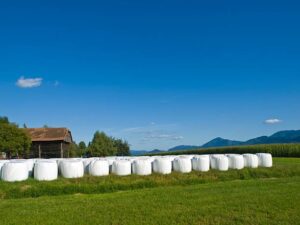Silagewrap silage plastic is a film that protects silage bales from oxygen, moisture, and other contaminants. It is made from low-density polyethylene (LDPE) and offers many benefits for farmers.
Its UV protection prevents damage caused by direct sunlight and allows it to hold its strength for a long time. It also provides elasticity and tact, which helps it create an airtight seal around the bales.
Strength per unit weight
 When choosing silage plastic, consider its weight and tensile strength per unit. These factors determine how much pressure a film can withstand before it begins to tear. The higher the tensile strength, the stronger the plastic. The power of plastic also determines how well it can protect crops from air and moisture.
When choosing silage plastic, consider its weight and tensile strength per unit. These factors determine how much pressure a film can withstand before it begins to tear. The higher the tensile strength, the stronger the plastic. The power of plastic also determines how well it can protect crops from air and moisture.
A good quality film will keep out moisture and oxygen, thereby preserving the nutrients in your forage. It will also ensure that the forage is safe to eat later. It will also help you save money by eliminating the need for expensive silo or bunker storage. The film can also reduce damage during harvesting and transport.
One of the most common uses for this type of plastic is to wrap hay or straw bales to prevent spoiling. These plastics can also be used as a cover for silos and bunkers. In addition to avoiding spoilage, they provide a barrier that helps keep out dirt and other debris. This is especially useful for farmers with limited storage space or not wanting to invest in costly structures.
The essential characteristic of a high-quality Silagewrap silage plastic film is its ability to block oxygen and moisture. This is important because the fermentation process of ensiling requires an oxygen-free environment to be successful. The film should also be resistant to tears, as it must withstand the stresses of handling and transport. The best silage films are made of Metallocene Polyethylene or LLDPE.
KSI Supply offers an excellent product made with tri-extruded and cast polyethylene. This material has a high tensile strength and low stretchability. It is also abrasion-resistant and has excellent UV stability. It is the best choice for high-quality hay and straw silage, providing a perfect seal against oxygen ingress and moisture.
Many farmers have discovered that silage wrap and bunker cover products can significantly reduce their forage costs. The LDPE material is easy to use, durable, and inexpensive to replace. However, many farmers have found that disposing of the film is problematic. Moreover, most of them have not been able to find a dealer that recycles the plastic.
Tensile strength
This silage film is designed to protect hay and straw bales against oxygen and moisture, which can cause spoilage. It is available in a variety of thicknesses and widths to suit various needs, as well as having good UV resistance. It is also durable enough to resist abrasion and puncture. It is an excellent choice for farmers looking to save time and money.
The quality of a forage wrapping film depends on several factors, including clarity, strength, and chemical resistance. However, the most critical factor is its oxygen and water vapour permeability. If the film allows these contaminants to penetrate, it will not be able to protect the bales, and your investment in hay or straw will be lost. The best films are made from metallocene polyethylene, which offers a barrier against these contaminants.
Bales of fodder are often covered in Silagewrap silage plastic wrap to create an optimal environment for fermentation. This process is essential for preserving the nutritional value of the food and reducing harmful bacteria. The plastic is also treated with anti-UV additives to ensure it will not degrade from prolonged exposure to direct sunlight.
Forage wraps are made of a combination of different ingredients, such as recycled LLDPE and agave fibre, to improve the performance of the composite. Incorporating a synthesized compatibilizer helps to improve the interfacial adhesion between the different materials and provides more stability.
Adding these ingredients to the plastic will keep it stable and intact in high-quality storage. These plastics’ tensile strength and tear resistance are essential to their ability to protect silage, as they must be strong enough to hold the bales together.
In addition to tensile strength, a plastic forage film should have high tear and puncture resistance to ensure the bales will not break while making silage. It must be able to withstand the weight of the forage and the force of wind and rainfall. In addition, the plastic should resist abrasions and punctures from animal teeth and claws. To measure these qualities, a film can be subjected to several tests. One test measures the film’s resistance to bird pecking, while another evaluates the film’s strength using a Dart Drop Test.
